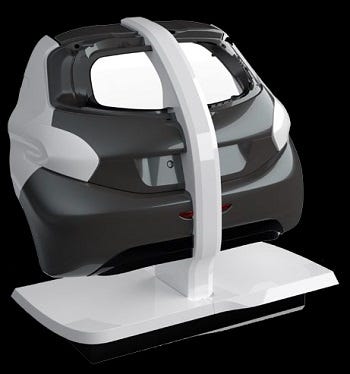The composite tailgate featured on the Peugeot 208 Hybrid Air 2L comprises a combination of plastic and carbon fiber, reducing weight by 35% or 7 kg. Developed by French Tier 1 Faurecia, the "semi-structural" design employed in the tailgate consists of a skin and a lining with a thickness of 1.5 mm to prevent torsion. This eliminates the need for additional strengtheners in flat areas by optimizing the direction of the carbon fibers in relation to the forces acting upon them.
October 14, 2014
The composite tailgate featured on the Peugeot 208 Hybrid Air 2L comprises a combination of plastic and carbon fiber, reducing weight by 35% or 7 kg. Developed by French Tier 1 Faurecia, the "semi-structural" design employed in the tailgate consists of a skin and a lining with a thickness of 1.5 mm to prevent torsion. This eliminates the need for additional strengtheners in flat areas by optimizing the direction of the carbon fibers in relation to the forces acting upon them.
|
Composite tailgate is more than one-third lighter than conventional metal and glass design. |
The stiffness and reduced density have also made it possible to remove one of the two tailgate stabilizers to further reduce weight. A groove is also molded into the lining to accommodate the electrical cables and reduce the number of fasteners.
Faurecia's technology reportedly offers a number of other advantages in addition to the weight savings resulting from the use of composite materials, including: the removal of interior trim components as a result of the quality of the carbon fiber material, which can be painted directly; a reduction in the number of parts to be assembled such as mechanisms (a single tailgate stabilizer); the integration of features to facilitate assembly (e.g. electrical-cable grooves); the ability to produce more complex shapes than with parts made of metal or glass, such as the rear window.
The "low-cost carbon-fiber project" (FORCE) launched by the Plateforme de la Filière Automobile (PFA) in France should make carbon fiber composites more affordable and ensure that they begins to appear on mass-production models in the next eight years.
Faurecia has also trimmed the weight of bumpers by reducing their thickness from 3 mm to 2.5 mm, enabling weight savings in the region of 500 g for each bumper, or 1 kg per vehicle, representing an improvement of 11% compared with conventional bumpers.
About the Author(s)
You May Also Like



